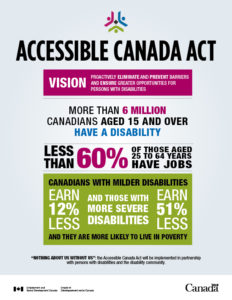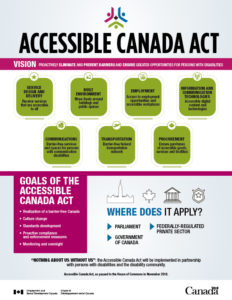Canada Without Barriers
It’s been a long road but the end is in sight. On May 13, 2019, the Senate of Canada passed the third reading of Bill C-81, the Accessible Canada Act. As the bill heads back to the House of Commons for a vote, it seems almost certain to receive Royal Assent. What will this historic legislation mean for people living with a disability? What would a barrier-free Canada look like?
A significant and positive change is that Bill C-81 will shift the responsibility on to the system and away from the individuals facing barriers in their daily lives. – The Honourable Jim Munson, Senator
As outlined on the the Government of Canada website, the purpose of the bill is to make Canada barrier-free in areas under federal jurisdiction. The bill outlines how to identify and remove accessibility barriers and prevent new barriers, under federal rule, including in:
- built environments (buildings and public spaces);
- employment (job opportunities and employment policies and practices);
- information and communication technologies (digital content and technologies used to access it);
- procurement of goods and services;
- delivering programs and services; and
- transportation (by air as well as by rail, ferry and bus carriers that operate across a provincial or international border).
The principles of the bill are rooted in the understanding that barriers to accessibility are at the heart of inequalities between Canadians with and without disabilities. The main principles are: inherent dignity; equal opportunity; barrier-free government; autonomy; inclusive design; and meaningful involvement.
An acces sible Canada act is a long-overdue. (The United States created the Americans with Disabilities Act in 1990.) 6.2 million — or about 22% of — Canadians aged 15 years and older reported being limited in their daily activities due to a disability. This percentage is expected to increase in the coming years due to Canada’s aging population, since the prevalence of disability increases with age.
sible Canada act is a long-overdue. (The United States created the Americans with Disabilities Act in 1990.) 6.2 million — or about 22% of — Canadians aged 15 years and older reported being limited in their daily activities due to a disability. This percentage is expected to increase in the coming years due to Canada’s aging population, since the prevalence of disability increases with age.
If Parliament passes the bill, the Canadian Human Rights Act, the Canada Transportation Act, the Telecommunications Act and the Broadcasting Act will need revisions to reflect the new legislation – a lengthy process. Shifting attitudes toward inclusion for people with disabilities might take more time. There is hope.
As we become more conscious of the uniqueness of others, we become aware of our common humanity. We are all fundamentally the same, no matter what our age, gender, race, culture, religion, limits or handicaps may be.
– Jean Vanier, the late founder of L’Arche
National AccessAbility Week is May 26 – June 1, 2019


